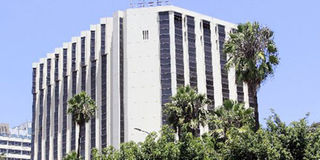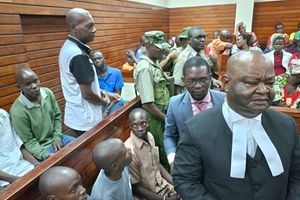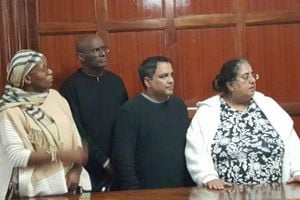Politics, twists and turns of the city’s most coveted plot

Laico Regency hotel, formerly Grand Regency, in Nairobi on February 6, 2016. It was during 1974 that NSSF was sold the NSSF plot — as Pattni managed to build his Grand Regency Hotel. PHOTO | NATION MEDIA GROUP
What you need to know:
- Ambani had intended to purchase the National Social Security Fund-owned plot for Sh1.3 billion before it turned out that it was smaller than what was indicated on the title.
- Also, the ministry of Finance and Planning, under Mr Kibaki, had started discussions with various entrepreneurs such as Holiday Inn to develop the site.
- The land remained empty and the only person who was temporary allocated “Plot L” — at the corner of Uhuru Highway and University Way, was Cabinet minister Stanley Oloitiptip.
Last week, Indian billionaire Mukesh Ambani sued the Kenya Revenue Authority seeking a Sh55 million stamp duty refund he had paid after a deal to purchase an empty plot at the junction of Uhuru Highway and Kenyatta Avenue collapsed.
Ambani had intended to purchase the National Social Security Fund-owned plot for Sh1.3 billion before it turned out that it was smaller than what was indicated on the title.
NSSF had bought the plot from Moi-era wheeler dealers who had indicated that it was 1.9 acres while it was 1.4 acres — a crafty scheme used to milk NSSF by Kanu carpetbaggers.
That is how Ambani’s dream of building a 21-storey Delta Hotel opposite the Laico Regency collapsed. He moved to Westlands where he built Delta House.
That NSSF plot — and several others up to the Uhuru Highway/University Way junction — tell the story of how senior government officials and ministers used their offices to try to set up private companies to build hotels on the site.
In 1970s, the NSSF plot — then owned by the central government — was regarded as the most prestigious piece of land and President Jomo Kenyatta had asked the Commissioner of Lands, Mr J.A O’Loughlin, not to advertise it for sale.
Apart from these two plots, the others from Uhuru Highway/Kenyatta Avenue junction had been reserved as a perimeter car park.
Now political pressure was on Mr O’loughlin to give up that area.
Initially, the current NSSF plot and the adjacent one — where Barclays Plaza is located — were to be given to East African Airways to develop terminal facilities and a hotel.
The idea was to have passengers book their flights there, and if they wanted, they could as well be accommodated in the hotel.
It was hoped that the two buildings would enhance the profitability of both and be convenient to visitors.
But EAA started having cash problems and in March 1971 the Permanent Secretary in the Ministry of Power and Communication, Mr S.B Ogembo, told the Lands Commissioner that the ministry was not satisfied with EAA’s inability to develop the site.
That opened the floodgates to interested parties — Cabinet ministers Mwai Kibaki, Daniel arap Moi, Dr Njoroge Mungai, Odongo Omamo, Mathews Ogutu, and various billionaires led by mining magnate Tiny Rowland.
INTERESTED PARTIES
In August 1972, President Kenyatta — perhaps pestered to give away plots there — asked the Lands Commissioner to confirm if there were hotel sites available in Nairobi.
Indeed, the commissioner directed him to this NSSF plot. In his letter, he enclosed a plan of the land which he indicated was measuring 250 by 180 metres.
He edged this plot in red. He also showed President Kenyatta another vacant plot which he edged in green, for the proposed East African Airways terminal and which had been allocated since 1969.
President Kenyatta was told that the Kenya Tourist Development Corporation had also indicated that it wanted a share in the new development and had started scouting for investors.
Also, the ministry of Finance and Planning, under Mr Kibaki, had started discussions with various entrepreneurs such as Holiday Inn to develop the site.
What the Lands Commissioner never told Mr Kenyatta was that his Cabinet ministers were pushing for some foreign interests and that they had formed firms to get the lucrative plots here.
The only thing that Mr O’Loughlin told the President was that the hotel and the terminal should ideally be developed as one complex as the presence of the terminal would enhance the viability of the hotel.
He proposed that, given that the EAA had no money, “we must go for the hotel development soon in order to sterilise the site indefinitely”.
It was Mr O’Loughlin who proposed that the government should have a share in such a hotel and told Mr Kenyatta that such a project required “skilled treatment, ownership and management”.
He suggested that firms such as Holiday Inns, Sheraton Hotels, or the German group Nekermann should be brought on board as investors.
It was after receipt of the letter that Mr Kenyatta said the land should not be advertised and instructed Mr O’Loughlin — “in view of its prestige position” — to obtain details of the proposals from interested parties that had made applications.
Since it was not advertised, only those in Kenyatta’s inner circle got to know of the availability of these plots.
Within six months, when it became clear that the Commissioner of Lands was scouting for investors, applications poured in from these well-connected people.
The first was from two businessmen, a Mr M. Muhoho and Mr D. Karanga, who hid behind a Nairobi investment management company, Longwe and Company, which applied to develop this plot.
The two proposed to build a 500-bed luxury hotel and stated that they would negotiate a management agreement with Sheraton International, an American chain with hotels and inns in both Africa and the Middle East.
Although Mr Muhoho and Mr Karanga said they intended to raise 40 per cent of the capital, Mr Kenyatta was secretly told that they did not have such capital.
RAISING CAPITAL
The next group was led by Finance minister Mwai Kibaki and they had formed a new company, Tubogo Consolidated Holdings Ltd. (The name Tubogo was Kikuyu for “little buffaloes”).
The other directors were George Wanyee, Dr James Itotia, Njuna Gahaico and Henry K. Wanyee.
Their proposal was to erect a 600-bed first class hotel at a cost of £3.5 million with Tubogo contributing 15 per cent of the cost.
The balance was to be sourced from Coutinho Caro and company Ltd of Hamburg and New York.
The Kibaki group had gone ahead and asked Chuddha International to make the designs which had been submitted to Hyatt International USA to impress them to enter into a management arrangement with Tubogo Consolidated.
But a secret note to Kenyatta indicated that the Kibaki group had not submitted any satisfactory bankers’ reference and had not shown the ability of Messrs Coutinho Caro to raise the balance.
The firm had indicated that they would raise the funds if the plot was allocated to Tubogo Consolidated.
The Kibaki group intended to first mortgage the property to raise the money and Tubogo was to raise its money through a second charge.
It was a clever way of using a public plot to raise money for a private enterprise.
The next group coalesced around former Vice President Joe Murumbi and formed a company known as Grand Hotels Ltd.
Its other directors were listed as Ishmael Kimani, J. Nganga and Nairobi lawyer Prof G.G.S Munoru.
While this company had a fully paid capital of Sh1 million and wished to erect a 976-bed hotel at a cost of £2 million, their ambitions collapsed after their financier, Investeco (Africa) Ltd, pulled out.
The other group was led by Defence minister Njoroge Mungai, who had nominated his relative, N Mbucuca, to hold his stake.
The others were Kenyatta’s son-in-law, Udi Gechaga, economist Chris Malavu, and civil servant Dunstan Omari.
Their proposal indicated that a Mr W. Jeter Eason had agreed to make available $350,000 to the four Kenyans as their 20 per cent stake in the new company, Capital Development (Kenya) Limited.
The other shareholders included D.C. Mlamba (a Kenyan Permanent Secretary), American J. Fulmer, a British W.E.F Samuel, Dane citizen A.P. Nienstaedt and two US citizens E.E. Ericson and R.G. Ory.
While they had proposed to associate with Kenya Tourism Development Corporation, the parastatal said it was not comfortable with the politicos and civil servants on board.
ASSESSING APPLICATIONS
The Mungai group had intended to build a 600-bed hotel costing £2.7 million and wanted to raise loan capital by charging the property.
Holiday Inn had accepted to participate and to provide 10 per cent of the equity while a Mr J. Cath of Morgan Guarantee Trust of New York had offered to provide 20 per cent of the equity.
Another group that wanted the plot was led by Tourism and Wildlife minister Mathew Ogutu and his counterpart Odongo Omamo.
They had hid their bid in a company known as International Business Representatives (EA) Ltd whose managing director was Mr J. Omondo, and wished to build a 1,000-bed hotel of international Class A standard at cost of £3.7 million.
The Ogutu group had managed to get the financial backing of Voyer and Company, a large French construction firm who had stated they were ready to finance the venture.
A banker’s reference was also received from Credit Lyonnais and Banque Nationale de Paris regarding the contractors.
They were then negotiating with Trust House-Forte, a British hotel group chain, to manage the hotel.
The last group, and which was recommended to Kenyatta, was a Japanese consortium, Ataka & Company Ltd, which had entered into an agreement with the Kenya Tourist Development Corporation.
They wanted to build a 600-bed facility. KTDC was to get a 49 per cent stake while Ataka would get 51 per cent.
Ataka comprised the Seibu group which was then operating some 32 hotels in Japan, including the wellknown Prince Hotel Group.
Subject to Mr Kenyatta’s approval, they had proposed that the name of the new hotel be “The President”.
Apart from the Dr Mungai group and the Ataka Group, the Commissioner of Lands told President Kenyatta that most of the other applications may not be able to provide Nairobi with a hotel within a stipulated time.
He asked Mr Kenyatta to form a committee to examine the applications.
What the various groupings did not know was that the Minister for Lands and Settlement, Mr Jackson Angaine, was against their participation in the project.
When he requested the view of his Deputy Secretary J. Adamba, they all agreed to back the Japanese “to ensure that none of these influential people is made to feel that he has been favoured over the others”.
A few months later, in October 1973, Udi Gechaga, who was married to Mr Kenyatta’s daughter Jeni, submitted another letter on behalf of Tiny Rowland’s Lonhro EA seeking to get the land between University Way, Kenyatta Avenue and Uhuru Highway. It was the most ambitious project in Nairobi.
Rowland, known to befriend African presidents to get whatever he wanted, had just completed building Bruce House and now wanted to act as “promoters for such an exercise”.
LONHRO PROJECT
We now know from archival correspondence that Mr Gecaga — father of Uhuru Kenyatta’s personal assistant Jomo Gecaga — was on a fishing mission, having failed to get the current NSSF plot.
The area he was targeting was described by the Commissioner of Lands as the “last large area of government-owned land in the central area of Nairobi”.
As Mr Gecaga was writing his request, the Japanese who had earned the ministry’s approval withdrew.
That now left Dr Njoroge Mungai’s group as the next viable option together with Udi Gecaga.
The connection here was that Udi Gecaga’s mother was Dr Mungai’s sister.
Special Branch boss James Kanyotu had managed to get a plot around this area to build his Special Branch headquarters, Nyati House.
He was previously housed in Dr Mungai’s Queensway House along University Way.
According to Mr Gecaga, Lonhro wanted to develop a series of buildings from the current Nyayo House to Uhuru Highway-University Way junction.
Mr Gecaga held several meetings on his proposal with Mr O’Loughlin, who found “merit” in it although he was “reluctant to see one developer permitted to become the chief developer and landlord of such a large portion of the remaining government land in the city centre” .
In his letter to N.S Kungu, the Lands PS, Mr O’Loughlin proposed that the current NSSF plot, Laico Regency land and Barclays Plaza area should be held until the government had an opportunity to consider the matter.
The only commitments made then were on the Special Branch, Maendeleo ya Wanawake, EAA Terminal and headquarters for Provincial Commissioner, which was supposed to be at the current Anniversary Towers area.
(This plot was later allocated during the Daniel arap Moi years and sold to Kenya Re!)
Back to Lonhro: top officials resisted Mr Gecaga’s moves — an issue that divided the government.
One letter summarised the feelings: “In view of the very high demand for plots close to the city, it would be impossible to justify the allocation of the entire area to one developer irrespective of his ability to carry out the development,” wrote Mr J Adamba, deputy secretary of Lands.
“This organisation has become notorious, particularly in the African continent, and their application seems to be a major bid on their behalf to establish an important stake in Nairobi... I have no doubt that the Lonhro people may stop at nothing to ensure they get what they want...” Mr Adamba told PS Kungu.
Indeed, and as predicted, Gecaga went to seek the support of powerful Nairobi Town Clerk J.P. Mbogua, who wrote to the Commissioner of Lands supporting Lonhro’s application.
He described it as “an added advantage… (that) will certainly enhance our international reputation.”
His letter was dated December 27, 1973.
When word went round that Mr Mbogua had written a letter in support of Lonhro, the Lands PS complained to his Deputy Secretary: “I do not like the scheme. It is too much of a commitment to one company. The mood in the country at the moment is for private and individual ownership.”
MOI'S ATTEMPT FAILS
Others drawn to support the Lonhro project included Mr Andrew Ligale (later Vihiga MP), who was then director of Physical Planning.
He proposed the construction of 13-storey buildings on this stretch and supported the building of residential houses by Lonhro — “not only for executives, but also for minor civil servants and clerks who wish to be close to their work”.
We now know that Tiny Rowland wanted to create a property holding company of which he would own 49 per cent share while the balance would be subscribed by Kenya citizens — a chance to bring politicians on board.
But after a meeting in January 1974 between Mr Gecaga and Mr O’Loughlin, the Commissioner dropped the bombshell:
“We… decided to recommend to you that… the government could not agree to their comprehensive proposal.”
With that Mr Gecaga went to see the PS, Office of the President, Mr Geoffrey Kariithi — then the most powerful man in the Kenyatta regime.
As the Lands PS (Kungu) was seeking the support of Finance PS Phillip Ndegwa and Minister Mwai Kibaki, Mr Kariithi drafted a letter supporting the project.
In turn, Mr Ndegwa wrote another later opposing the project, creating a political stand-off.
Mr Ndegwa wrote: “I entirely agree with you that the proposal from Lonhro should be turned down… it does not appear attractive…” while Mr Kariithi, who said he was given the proposal by “a third party”, described it as “a very good one”.
PATTNI'S ENTRANCE
That April, 1974 Vice President Daniel arap Moi started pushing the interests of a Japanese company Chori to build a hotel near the corner of Uhuru Highway and University Way.
He asked Mr Angaine to “give his blessings” to allow the Commissioner of Lands to “give them a direct grant”.
Finally, the Lonhro project was trashed and Moi’s attempt to get the Japanese investors some plots here failed.
The land remained empty and the only person who was temporary allocated “Plot L” — at the corner of Uhuru Highway and University Way, was Cabinet minister Stanley Oloitiptip.
But this was taken back three months after President Kenyatta’s death and allocated to a new firm: Uhuru Highway Development Ltd.
This new firm was associated with banker Mohammed Aslam, Mr Hedam, Kamlesh Pattni and others.
During the Goldenberg inquiry, the Commission was told that Mr Hedam stood for His Excellency Daniel arap Moi.
It was during this period that NSSF was sold the NSSF plot — as Pattni managed to build his Grand Regency Hotel.
The rest is history.
[email protected] @johnkamau1





